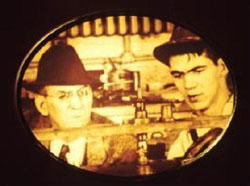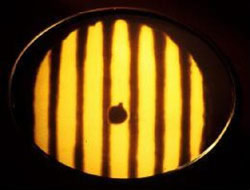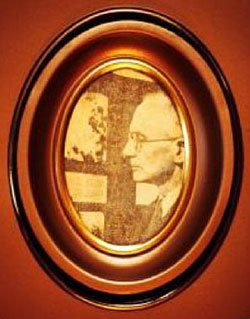
The personal log of Clarence T. Jones and his sons as they ground and figured the 20.5 inch primary and its secondary is a study in innovation and craftsmanship.
It begins with “Miscellaneous Work” on January 4, 1937. By March fourth the primary blank was mounted on the grinding lap and a facing tool was completed. The tool was rigged to the motor drive and cross head the next day. The blank was brought two a 204 inch radius with #120 Aloxite compound and reached a 196 inch radius with #800 Carborundum. FFF Carborundum was used to polish for Foucault and Ronchi testing. The polishing continued to bring the surface of the mirror to a 99.9 inch radius on March 12. The log shows that the focal length was measured by a steel tape on March 16 at 96 5/16 inches.

Zonal testing was completed on March 19, 1937. A note in the log by W. H. Wilson states, “Examination by Foucault and Ronchi tests indicate in my opinion, a mirror of a very high order of perfection”.
The secondary mirror which returns the light path to the cassegrain center hole in the primary mirror was mounted for grinding on April 16, 1937. Mr. Jones was by his own admission very concerned that his knowledge of the optics would be put to the test, as he remarked in the log, “We can’t say eureka yet”. Indeed the work was cut out for Mr. Jones and his sons, he had no previous experience with large convex mirrors and few in the amateur world were able to help. He considered leaving the instrument as a Newtonian diagonal system, but as he put it, “We are going to do it, Cassegrain telescopes have been built, we can build one”. He ground the first mirror for a trial and mounted it at 74.6 inches and figured the return path for 89.6 inches to the cassegrain focus 15 inches behind the primary.

The secondary mirror blank presented problems from the beginning. Mr. Jones had calculated the diameter needed at 5.1 inches. He began by cutting down the diameter of a 6 inch blank to 5.5 inches. He records in the log, “The next day after we mounted it we found it had a bad stress problem and could not be corrected after several tries”. A new blank was ordered June 5, 1937. He notes on July 22 that the same “zoning problem” with the new blank was troubling him. On July 25 it was elected to go much slower with the, “tool on top”. The mirror was mounted for testing and found to be satisfactory. The Mirrors were silvered by Brosher’s method. Mr. Jones describes the Formaldehyde Process but said that it was to be used as an emergency method only.

The instrument was presented at a public ceremony on July 30, 1937.
The First directorship of the Brainerd Observatory as it was called at the time was filled by the Nashville Prof. Latimer J. Wilson. Ancillary research by Dr. James X. Gorgen shows Prof. Wilson became a member of the Tennessee Academy of Science in 1912. He resigned the new directorship however after only two months because of a commuting problem between his lectures at Watkins Institute in Nashville. He was succeeded for a time by the famous radio personality and astronomy lecturer, Major Edward Bowes.

